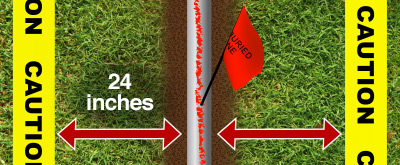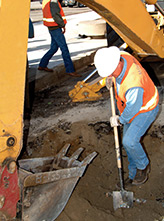
CALL
 Dig safe Look up and live
Injury or possible death can result from contact with any overhead or underground power line, large or small. Even the service wires that run from utility poles to buildings and pumps are potentially dangerous. Keep yourself and all tools and equipment at least 10 feet away from overhead power lines. Only qualified line clearance personnel can work in the 10-foot safety zone. High voltages require a larger safety zone. Before work begins, your crew leader must brief you about power line voltages in your work area and the clearances required to get the job done safely. Make the call |
|
Review these tips with coworkers at your tailgate or tool box meetings before work begins to help avoid potential hazards when working near underground utilities. 
What is the tolerance zone? If you are digging within the tolerance zone in California, any underground facilities that are in conflict with your excavation must be located with hand tools and protected before power equipment is used. If you wish to use vacuum excavation to locate marked facilities within the tolerance zone, you must first obtain the permission of the facility operator and you must inform the 811 service of your intent to use a vacuum excavation device when obtaining a dig ticket.
Dig with care
Proceed with caution Would you like to know more? Do you like this email series? |
|||
| #11189 |
